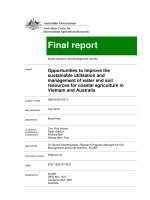PROMOTING A UNIVERSITY CULTURE OF INNOVATION AND PRODUCT DEVELOPMENT FOR IGR
Bạn đang xem bản rút gọn của tài liệu. Xem và tải ngay bản đầy đủ của tài liệu tại đây (146.73 KB, 35 trang )
PROMOTING A UNIVERSITY CULTURE
OF INNOVATION AND PRODUCT
DEVELOPMENT FOR IGR
BY
PROF. SAMUEL T. WARA, PhD, R. Eng (COREN), FNSE,
FIET, FRHD
DIRECTOR, CUCRID
ON THE OCCASION OF THE EXECUTIVE ADVANCE –
2015/2016 ACADEMIC SESSION FOR FACULTY AND SENIOR
NON – TEACHING STAFF
THEME – INNOVATION, PRODUCT DEVELOPMENT
AND NATION BUILDING
PRESENTATION SUMMARY
•
•
•
•
QUESTIONS/.FOOD FOR THOUGHTS
DEFINITION OF KEY WORDS
CONCEPTS FOR PROMOTION
MARKETING
STRATEGIES
FOR
DEVELOPED PRODUCTS
• TYPES OF PRODUCTS
• BENEFITS FROM INNOVATION AND
PRODUCT DEVELOPMENT
• FINAL WORD/RECOMMENDATIONS
QUESTIONS/FOOD FOR THOUGHT
• Can IPD serve as a means of IGR/ what
relationship exist between I & PD and IGR
• How can this be done/How should the process
be driven (Culture)?
• How can the process be managed/role of all
stakeholders/partners (students, faculty, staff,
industries etc)?
• How should the process /programme for IPD
be funded to maximize IGR? – Internal and
external grants; what roles
QUESTIONS/FOOD FOR THOUGHT –
CONT’D
•
How do we protect our ideas and products whilst
advertizing
and
selling
them
(pre/post
development)?
• What strategies should we deploy to develop,
popularize,
commercialize
and
sell
our
products/does our local community know/use our
products?
• Can partnerships and intents/needs help/facilitate
research, Innovation and product development
• What disruptive tools can we consider besides the
norms of promotions, bonuses, incentives, discounts
etc – to have an edge and distinguish ourself from
the multitude?
DEFINITION OF KEY WORDS
PROMOTION
• the method you use to spread the word about your
product or service to customers, stakeholders and
the broader public;
• a program that sells or advertises something;
• raising customer awareness of a product or brand,
generating sales, and creating brand loyalty.
CULTURE
• relates to the habits, beliefs, and traditions of a certain
people ;
• it is the characteristics and knowledge of a particular group
of people
DEFINITION OF KEY WORDS – CONT’D
INNOVATION
• a new idea, method, or device : novelty;
• something new or different introduced;
• a more effective device or process.
• the application of better solutions that meet new
requirements, in articulated needs, or existing market
needs.
•
something original and more effective and, as a
consequence, new, that "breaks into" the world
space( market or society)
• This
could
be
accomplished
through
more
effective products, processes, services, technologies,
or ideas that are made readily available to society,
markets, governments etc..
DEFINITION OF KEY WORDS – CONT’D
PRODUCT
• A good, idea, method, information, object or service created as
a result of a process and serves a need or satisfies a want.
• a combination of tangible and intangible attributes (benefits, fea
tures, functions, uses) that a seller offers a buyer for purchase.
For example a seller of a toothbrush not only offers the physical
product but also the idea that the consumer will be improving
the health of their teeth.
• Legally, it is any commercially distributed good that is
a tangible
personal
property; output or
result
of
a fabrication, manufacturing, or production process, and which
passes through a distribution channel before being consumed or
used.
DEFINITION OF KEY WORDS – CONT’D
• In marketing, it is any good or service that
most closely meets the requirements of a
particular market and yields enough profit to
justify its continued existence. Example car
manufacturing
and
accessories
manufacturers(main
and
downstream/subsidiary companies)
• DEVELOPMENT - the act of improving by
expanding, enlarging, or refining
• IGR - the total amount of money received by
the company(Covenant) for goods sold or
services provided
STRATERGIES FOR PROMOTION
OF DEVELOPED PRODUCTS
• (Innovation
And
Product
Marketing/Commercialization)
• Promotion is the method you use to spread the word
about your product or service to customers,
stakeholders and the broader public. Identifying the
target market/end users is key.
• there is need to identify the best way to reach your
target.
• There is no single wholesome method but a
combination from the following: advertising, personal
selling, referrals, sales promotion and public relations
to promote their products or services.
STRATERGIES FOR PROMOTION
OF DEVELOPED PRODUCTS - cont’d
• ADVERTISING : What is advertising?
• a form of communication designed to persuade
potential customers to choose your product or service
over that of a competitor
• Successful advertising involves making your products
or services positively known by that section of the
public most likely to purchase them.
• It should be a planned, consistent activity that keeps the
name of your business and the benefits of your products
or services uppermost in the mind of the consumer.
STRATERGIES FOR PROMOTION OF
DEVELOPED PRODUCTS - cont’d
• BENEFITS OF ADVERTIZING/Why advertise?
• The objective of advertising is to increase your
profit by increasing your sales. Advertising aims to:
• Make your business and product name familiar to
the public
• Create goodwill and build a favourable image
• Educate and inform the public
• Offer specific products or services
• Attract customers to find out more about your
products
STRATERGIES FOR PROMOTION OF
DEVELOPED PRODUCTS - cont’d
METHODS
• Stationery
•
Window display
office front
• Press advertising
• Radio
• Television
• Direct mail
• Outdoor
• Ambient
• Cinema
•
or
Point of Sale( we could
partner with all our
LFC all over Nigeria
and the world)
• Online(internet, social
media, webpage. SMS)
•
Directory
listings(product
brochure, known yellow
pages)
• Evaluating
the
effectiveness of your
advertising(feedback)
STRATERGIES FOR PROMOTION OF
DEVELOPED PRODUCTS - cont’d
What is selling? How do we sell CU products?
the exchange of goods or services for an agreed sum of
money
The process may include one, some or all of the following
stages:
Prospecting and qualifying – identifying qualified
prospects ie: those that are likely to want or need your
product or service and can afford to pay for it.
Pre-approach – undertaking research about prospects to
assist in the actual selling process.
Approach – making actual contact with the prospect in
person, by phone or in writing
STRATERGIES FOR PROMOTION OF
DEVELOPED PRODUCTS - cont’d
Sales Promotion
• What is sales promotion?
Relates to
• short term incentives or
• activities that encourage
the purchase or
• sale of a product or
service. ).
EXAMPLES
bonuses,discounts,scholarshi
ps, sponsorships etc
• What are the major sales
promotion activities?
Activities can be targeted
toward
• final buyers (consumer
promotions),
• business customers
(business promotions),
• retailers and wholesalers
(trade promotions) and
members of the sales force
(sales force promotions
STRATERGIES FOR PROMOTION OF
DEVELOPED PRODUCTS - cont’d
Public Relations
Public Relations
What is public relations?
• The Public Relations Institute
of Australia (PRIA) defines
Public Relations (PR) as:
“The deliberate, planned and
sustained effort to establish
and
maintain
mutual
understanding between an
organisation (or individual)
and its (or their) publics”.
• simply,
building
good
relations with the stakeholders
(public) of your business by
obtaining
favourable
publicity, building a good
corporate image and handling
or heading off unfavourable
rumours, stories and events.
• By building good relationships
with
your
stakeholders,
particularly customers, you
can generate positive word of
mouth and referrals from
satisfied customers
STRATERGIES FOR PROMOTION OF
DEVELOPED PRODUCTS - cont’d
PROCEDURE FOR NEW PRODUCT
DEVELOPMENT(PNPD)
PROCEDURE FOR NEW PRODUCT
DEVELOPMENT(PNPD)
•
•
•
•
•
This is the complete process of
bringing a new product to market.
It is the transformation of a
market opportunity into a product
available for sale and
it can be tangible (that is,
something physical you can touch)
or intangible (like a service,
experience, or belief).
A good understanding of customer
needs and wants, the competitive
environment and the nature of the
market represent the top required
factors for the success of a new
product.
•
Cost, time and quality are the main
variables that drive the customer
needs. Aimed at these three
variables,
companies
develop
continuous practices and strategies
to better satisfy the customer
requirements and increase their
market share by a regular
development of new products.
There are many uncertainties and
challenges throughout the process
which companies must face. The use
of best practices and the elimination
of barriers to communication are
the main concerns for the
management of NPD process.
MARKETING A NEW
PRODUCT/UNIVERSITY PRODUCTS
Stages of Marketing considerations
• Idea Generation
– SWOT ANALYSIS (Strengths, Weaknesses, Opportunities &
Threats).
– Market and consumer trends, competitors, focus groups,
employees, sales people, corporate spies, trade
show/EXHIBITIONs may also be used to get an insight into
new product lines or product features.
– Lots of ideas are generated about the new product. Out of
these ideas many are implemented. The ideas are
generated in many forms. Many reasons are responsible
for generation of an idea.
• OPPORTUNITY ANALYSIS
MARKETING A NEW
PRODUCT/UNIVERSITY PRODUCTS
Idea Screening
•
The object is to eliminate
unsound concepts prior to
devoting resources to them.
•
The screeners should ask
several questions:
•
•
Will the customer in
the target
market benefit
from the product?
What is the size and growth
forecasts of the market
segment / target market?
Idea Screening
•
What is the current or
expected
competitive
pressure for the product
idea?
•
What are the industry sales
and market trends the
product idea is based on?
•
Is it technically feasible to
manufacture the product?
•
Will
the
product
be
profitable
when
manufactured and delivered
to the customer at the target
price?
MARKETING A NEW
PRODUCT/UNIVERSITY PRODUCTS
• Idea Development and Testing
– Develop the marketing and engineering details
• Investigate intellectual property issues
and
search patent databases
• Who is the target market and who is the
decision maker in the purchasing process?
• What product features must the product
incorporate?
MARKETING A NEW
PRODUCT/UNIVERSITY PRODUCTS –
cont’d
• What benefits will the product provide?
• How will consumers react to the product?
• How will the product be produced most cost
effectively?
• Prove feasibility through virtual computer aided
rendering and rapid prototyping
• What will it cost to produce it?
– Testing the Idea may involve asking a
number of prospective customers to
evaluate the idea
MARKETING A NEW
PRODUCT/UNIVERSITY PRODUCTS
• Business Analysis
Estimate likely selling price based upon
competition and customer feedback
Estimate sales volume based upon size of market
Estimate profitability and break-even point
MARKETING A NEW
PRODUCT/UNIVERSITY PRODUCTS
• Beta Testing and Market Testing
– Produce a physical prototype
– Test the product (and its packaging in typical usage
situations
– Conduct focus group customer interviews or introduce
at trade show
– Make adjustments where necessary
• Produce an initial run of the product and sell it
in a test market area to determine customer
acceptance
MARKETING A NEW
PRODUCT/UNIVERSITY PRODUCTS
Technical Implementation
•
•
•
Engineering operations
planning
•
Department scheduling
•
Supplier collaboration
New program initiation
Finalize Quality
management system
•
Resource estimation
•
Logistics plan
•
Requirement publication
•
Resource plan publication
•
Publish technical
communications such
as data sheets
•
Program
review
monitoring
•
Contingencies
planning
-
and
what-if
COMMERCIALIZATION
Launch the product
Produce and place advertisements and
other promotions
Fill the distribution pipeline with
product – How?
Critical path analysis is most useful at
this stage
New Product Pricing
Impact of new product on the entire product
portfolio
Value Analysis (internal & external)
Competition
and
alternative
competitive
technologies
Differing value segments (price, value and need)
Product Costs (fixed & variable)
Forecast of unit volumes, revenue, and profit









